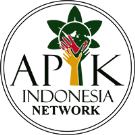PEMANFAATAN SERASAH MANGROVE Rhizopora sp SEBAGAI BIOSORBEN UNTUK SORPSI LIMBAH
DOI:
10.29303/jbl.v2i2.180Published:
2019-08-01Issue:
Vol. 2 No. 2 (2019)Keywords:
Biosorben, Litter, Rhizopora sp, Waste, Lead, Adsoprsi.Articles
Downloads
How to Cite
Downloads
Metrics
Abstract
Litter mangrove contains elements lignin-selulosa that can be adsorb heavy metal so that it can be modified into biosorben. Batik industry an industry that potentially produce waste containing heavy metal so that it can be caused damage environment .One of a breed of metal the polluter high priority found in sewage batik industry is lead. The purpose of this research to make use of litter mangrove as biosorben adsorption metal lead and applied on waste batik industry to adsorption metal lead . The condition steady adsorption lead by biosorben litter mangrove happened to pH 3 , contact time 30 minutes and weights biosorben 0.5 gram. Litter mangrove can be used as biosorben capable of absorbing metal lead of batik industry with capacity adsorption 0,6025 µg / g with efficiency adsorption 100 %. Isoterm adsoprsi lead by biosorben litter mangrove following a pattern isoterm freundlich assuming that happens adsorption physics form a multilayer worth regression 0,9213 but type isoterm langmuir having value regression less similar namely 0,9114.
Â
References
Agustina,T.E.,Nurisman E., Prasetyowati, Haryani, N.,2011. Pengolahan Air Limbah Pewarna Sintetis dengan Menggunakan Reagen Fenton. Prosiding Seminar Nasional AvoER Ke-3,Palembang.
Atkins, P.W.(1999). Kimia Fisik Jilid I Edisi Keempat. Erlangga. Jakarta.
Badan Standardisasi Nasional.(2004). SNI 06-6989.8-2004. Air dan air limbah – Bagian 8: Cara uji timbal (Pb) dengan Spektrofotometri Serapan Atom (SSA)-nyala.
Dean,J.A. 1999. Langes’s Handbook Of Chemistry. R.R. Donnelley & Sons Company. New York.
Febriyeni, N.D. (2010). Analisis Tembaga Kadmium dan Timbal dalam Udang Jerbuang dan Udang Pacet Secara Spektrofotomeri Serapan Atom. Skripsi. Fakultas Matematika dan Ilmu Pengetahuan Alam. Fakultas Farmasi. Universitas Indonesia. Depok.
Fernanda, L.(2012). Studi Kandungan Logam Berat Timbal, Nikel, Kromium dan Cadmium pada Kerang Hijau (Perna viridis) dan Sifat Fraksionalnya pada Sedimen Laut. Skripsi. Fakultas Matematika dan Ilmu Pengetahuan Alam. Departemen Kimia. Universitas Indonesia. Depok.
Handayani, M. dan E. Sulistiyono. (2009). Uji Persamaan Langmuir dan Freundlich Pada Penyerapan Limbah Chrom (VI) oleh Zeolit. Prosiding Seminar Nasional Sains dan Teknologi Nuklir. PTNBR – BATAN. Bandung.
Hartanti, N.U. Mutasih, S. Nurjanah. (2011). Pemanfaatan Serasah Daun Mangrove sebagai Pakan Cacing Lur (Dendonereis pinnaticiris). Diakses pada tanggal 23 Februari 2018.
Holtzapple, M. T. (2003). Hemicelluloses In Encyclopedia of Food Sciences and Nutrition. Academic Press. London.
Horsfall MJ, Abia AA, Spiff Al. (2003). Removal of Cu(II) and Zn(II) ions from wastewater by cassava (Manihot esculenta crantz) waste biomass. African J Biotechnol 2:360-364.
Krowiak, W, A., R. G. Szafran, S. Modelski. (2011). Biosorption of Heavy Metal from Aqueous Solutions onto Peanut Shell as a Low-cost Biosorbent. Desalination. Vol. 265, 126-134. Polandia.
Marshall, W. E. Dan Mitchel M. J. (1996). Agriculture by Product as Metal Adsorbent: Sorption Properties and Resistance to Mechanical Abrasion. J Chem Tehnol Biotechnol 66: 192-198.
Muliani, Nurbaya, Gunarto. (2013). Pemanfaatan Serasah Daun Mangrove (Rhizophora mucronata) Pada Pemeliharaan Udang Windu (Panaeus monodon) Di Laboratorium. Konferensi Akuakultur Indonesia. Balai Penelitian dan Pengembangan Budidaya Air Payau. Maros. Sulawesi Selatan.
Muljadi. (2009). Efisiensi Instalasi Pengolahan Limbah Cair Industri Batik Cetak dengan Metode Fisika Kimia dan Biologi Terhadap Penurunan Parameter BOD, COD dan Logam Berat Krom. Ekuilibrium. Vol 8 (1) : 7-6.
Mulyawan, R., Sefumillah, A., Folaintini. (2015). Biosorpsi Timbal Oleh Biomassa Daun Ketapang. Jurnal Molekul 10 (1) Hal. 45-46. Purwokerto.
Sasongko, D. P dan Tresna, W. P. (2010). Identifikasi Unsur dan Kadar Logam Berat pada Limbah Pewarna Batik dengan Metode Analisis Pengaktifan Neutron. Jurnal Ilmu Pengetahuan dan Teknologi TELAAH Vol 27,pp 22-27. Semarang.
Sembodo, B. T. (2006). Model Kinetika Langmuir untuk Adsorpsi Timbal pada Abu Sekam Padi. Ekulibrium Vol 5 (1) : 28-33.
Setiawan, A. dan Hamzah, F. (2010). Akumulasi Logam Timbal, Tembaga dan Seng di Hutan Mangrove Muara Angke, Jakarta Utara. Jurnal Ilmu dan Teknologi Kelautan Tropis Vol 2 No 2 Hal 41-52. Balai Risett dan Observasi Kelautan, Kementerian Kelautan dan Perikanan. Jakarta.
Somasundaran,P. 2006. Encyclopedia of Surface and Colloid Science. CRS Pres.New York.
Author Biographies
Mia Azizah, Universitas Nusa Bangsa
Mamay Maslahat, Universitas Nusa Bangsa
License
The Authors submitting a manuscript has understood that if accepted for publication on Jurnal Belantara, the copyright of the article shall be assigned to Jurnal Belantara of the Forest Study Program University of Mataram as the publisher of the journal. Copyright encompasses rights to reproduce and deliver the article in all forms and media, including reprints, photographs, microfilms, and any other similar reproductions, as well as translations.
Jurnal Belantara of the Forest Study Program University of Mataram and the Editors make every effort to ensure that no wrong or misleading data, opinions, or statements be published in the journal. In any way, the contents of the articles and advertisements published in Jurnal Belantara are the sole responsibility of their respective authors and advertisers.
We strongly encourage that manuscripts be submitted to the online journal system in http://belantara.unram.ac.id/index.php/JBL/index. Authors are required to create an account and submit the manuscripts online. For submission inquiries, please follow the submission instructions on the website. If the author has any problems with the online submission, please contact Editorial Office at the following email: [email protected]
Contributors are responsible for obtaining permission to reproduce any materials, including photographs and illustrations, for which they do not hold the copyright and for ensuring that the appropriate acknowledgments are included in the manuscript.
Users of this website will be licensed to use materials from this website following the Creative Commons Attribution 4.0 International License. No fees charged. Please use the materials accordingly.











